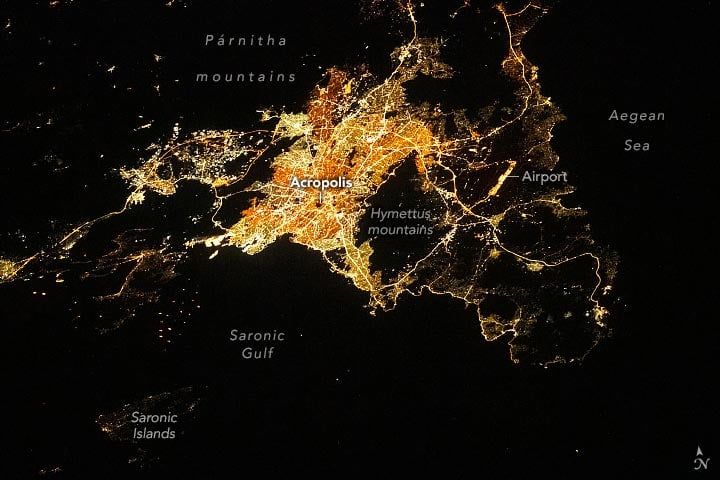
Photograph of Athens, Greece at night, captured on September 17, 2022, by an Astronaut onboard the International Space Station.
Stark contrasts between light and dark indicate the interface between urban and natural areas in the Greek capital.
An astronaut aboard the International Space Station took this nighttime photograph of Athens, the capital city of Greece. The city lies on the complex coastline of the Attica Peninsula in Southern Greece. Streets meander through the city like illuminated rivers, and the urban sprawl extends to the coast.
Urban Illumination and Geography
In nighttime photos taken from above, sharp transitions from lit to unlit areas often occur where urban development meets a waterbody or rough, undeveloped terrain. In this photo, illumination cuts off sharply at the southern edge of Athens, where the city meets the Saronic Gulf. The city’s northwestern reaches also display a sharp drop in illumination due to the Párnitha mountains. Likewise, the lack of light between the city and Athens International Airport is due to the rugged terrain of the Hymettus mountains. The range is blanketed with forests that host archaeological sites and recreational areas.
Historical and Modern Athens by Night
Ancient and modern elements in Athens are also contrasted at night. Yellow and orange-hued lights indicate older, high-pressure sodium lighting. Bright white-toned lighting indicates areas illuminated with more recent LED (light-emitting diode) technology. Small dark splotches in the central city area surround some of the major ancient landmarks from the fifth century BCE, including the Acropolis, the Parthenon, and the Temple of Olympian Zeus.
Astronaut photograph ISS067-E-372936 was acquired on September 17, 2022, with a Nikon D5 digital camera using a focal length of 180 millimeters. The image was provided by the ISS Crew Earth Observations Facility and the Earth Science and Remote Sensing Unit at Johnson Space Center. The image was taken by a member of the Expedition 67 crew. It has been cropped and enhanced to improve contrast, and lens artifacts have been removed. The International Space Station Program supports the laboratory as part of the ISS National Lab to help astronauts take pictures of Earth that will be of the greatest value to scientists and the public and to make those images freely available on the Internet. Caption by Sara Schmidt, GeoControl Systems, JETS II Contract at NASA-JSC.
>>> Read full article>>>
Copyright for syndicated content belongs to the linked Source : SciTechDaily – https://scitechdaily.com/illuminating-athens-greece-nighttime-wonders-from-space/































